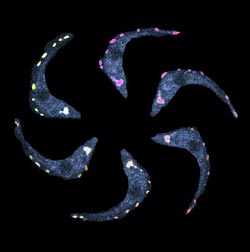A molecular delivery service

Building blocks for the assembly of a cilium are transported from the base to the tip of the cilium.<br>Copyright: Institut Pasteur, Paris <br>
For proper assembly and function of cilia, they need to be supplied with the appropriate building blocks. Scientists at the MPI of Biochemistry (MPIB) in Martinsried near Munich, Germany, now identified the mechanism of how Tubulin, the main building block of cilia, is transported within the cilium. The results now published in the journal Science could help to understand and potentially prevent these diseases.
Although cilia fulfill various tasks, they all have a similar structure: They are only five to ten micrometers (0.0005 to 0.001 centimeters) long and are located on the surface of eukaryotic cells. About 600 different ciliary proteins are synthesized inside the cell and then transported into the cilium. Disruption of this transport system, which scientists call intraflagellar transport (IFT), can lead to errors during the assembly of the cilia and thus cause diseases resulting in mental and physical symptoms. Mistakes in ciliary function can for example cause a “situs inversus”, a condition where the left/right arrangement of the inner organs in the body is reversed.
Even though the importance of the intraflagellar transport (IFT) and the cilium to human health has been known for a long time, a structural and mechanistic understanding of IFT has been missing so far. Scientists from the research group “Intraflagellar Transport” headed by Esben Lorentzen now succeeded in identifying the transport mechanism of the key protein Tubulin. It is the most abundant protein in the cilium and forms its backbone. “We found that the two proteins IFT74 and IFT81 work together to form a tubulin-binding module,” says Sagar Bhogaraju. When the researchers disturbed the binding of IFT74 and -81 to tubulin in human cells, it had severe impact on the formation of the cilia. “Our results provide the first glimpse into the assembly of the cilium at the molecular level,” says the biochemist.
Original Publication:
Bhogaraju, S., Cajanek L., Fort, C., Blisnick, T. , Weber, K., Taschner, M., Mizuno, N., Lamla, S., Bastin, P., Nigg, E. and Lorentzen, E.: Molecular Basis of Tubulin Transport within the Cilium by IFT74 and IFT81, Science, August 30, 2013.
DOI: 10.1126/science.1240985
Contact:
Dr. Esben Lorentzen
Structural Biology of Cilia
Max Planck Institute of Biochemistry
Am Klopferspitz 18
82152 Martinsried
Germany
E-Mail: lorentze@biochem.mpg.de
Anja Konschak
Public Relations
Max Planck Institute of Biochemistry
Am Klopferspitz 18
82152 Martinsried
Germany
Tel. +49 89 8578-2824
E-Mail: konschak@biochem.mpg.de
Weitere Informationen:
http://www.biochem.mpg.de/1890328/074_Lorentzen_IFT
– Link to the Press Release
http://www.biochem.mpg.de/en/news/pressroom
– Press Releases of the MPI of Biochemistry
http://www.biochem.mpg.de/en/rg/lorentzen
– Website of the Research Group “Intraflagellar Transport”
Media Contact
More Information:
http://www.biochem.mpg.deAll latest news from the category: Life Sciences and Chemistry
Articles and reports from the Life Sciences and chemistry area deal with applied and basic research into modern biology, chemistry and human medicine.
Valuable information can be found on a range of life sciences fields including bacteriology, biochemistry, bionics, bioinformatics, biophysics, biotechnology, genetics, geobotany, human biology, marine biology, microbiology, molecular biology, cellular biology, zoology, bioinorganic chemistry, microchemistry and environmental chemistry.
Newest articles

Bringing bio-inspired robots to life
Nebraska researcher Eric Markvicka gets NSF CAREER Award to pursue manufacture of novel materials for soft robotics and stretchable electronics. Engineers are increasingly eager to develop robots that mimic the…

Bella moths use poison to attract mates
Scientists are closer to finding out how. Pyrrolizidine alkaloids are as bitter and toxic as they are hard to pronounce. They’re produced by several different types of plants and are…

AI tool creates ‘synthetic’ images of cells
…for enhanced microscopy analysis. Observing individual cells through microscopes can reveal a range of important cell biological phenomena that frequently play a role in human diseases, but the process of…





















